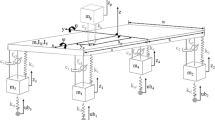Abstract
A quarter-automobile active suspension model was proposed. High speed on/off solenoid valves were used as control valves and fuzzy control was chosen as control method. Based on force analyses of system parts, a mathematical model of the active suspension system was established and simplified by linearization method. Simulation study was conducted with Matlab and three scale coefficients of fuzzy controller (k e, k ec, k u) were acquired. And an experimental device was designed and produced. The results indicate that the active suspension system can achieve better vibration isolation performance than passive suspension system, the displacement amplitude of automobile body can be reduced to 55%. Fuzzy control is an effective control method for active suspension system.
Similar content being viewed by others
References
LIU Shao-jun. Study on the Hydraulic Active Vibration Isolation System Based on the High Speed on/off Valve Technique and its Control Method [D]. Changsha: Central South University of Technology, 1997. (in Chinese)
GAO Yue-kui. Application of optimal control in vehicle active suspension system [J]. Heave Truck, 2000, 70(4):8–10. (in Chinese)
HAN Bo, WANG Qing-feng. Simulation research of hydraulic active suspension based on LQG [J]. Chinese journal of Mechanical Engineering, 1998, 34(6): 59–64. (in Chinese)
Peter K S T, Wen Tan. Direct composite H infinity controller design for a two-time-scale active suspension system [A]. IECON Proceedings (Industrial Electronics Conference)[C]. Floria, 1996. 1 401–1 405.
Gaspar P, Bokor J. Iterative model-based mixed H2/H infinity control design [A]. UKACC International Conference on Control[C]. London, 1998. 652–657.
Yousef Al-Assaf. Adaptibve control for vehicle active suspension system [A]. Proceedings of the American Control Conference[C]. Washington, 1995: 1 183–1 185.
Fukao T, Yamawaki A, Norihiko Adachi. Adaptive control of partially known systems using backstepping: application to H infinity design of active suspension [A]. Proceedings of the IEEE Conference on Decision and Control[C]. London, 1998. 481–486.
Supavut C, Huei Peng. Adaptive Robust Control for Active Suspensions [A]. Proceedings of the American Control Conference[C]. San Diego, 1999. 1 702–1 706.
Raman K M, Jayesh N A. Active Suspension Using Preview Information and Model Predictive Control [A]. Proceedings of IEEE International Conference on Control Applications[C]. New York, 1997. 860–865.
Myoungho S, Cheok K C, Huang N J. Model reference adaptive control for vehicle active suspension systems[A]. IEEE Transactions on Industrial Electronics[C]. Washington, 1991. 217–222.
Feldkamp L A, Puskorius G V. Neural Control Systems Trained by Dynamic Gradient Methods for Automotive Applications [A]. IJCNN-International Joint Conference on Neural Networks[C]. 1992. 798–805.
Richard H, Kenneth M. Neural network architectures for active suspension control[J]. Proceedings IJCNN-International Joint Conference on Neural Networks[C]. Baltimore, 1992. 765–770.
Yoshimura T, Nakaminami K, Kurimoto M, et al. Active suspension of passenger cars using linear and fuzzylogic controls[J]. Control Engineering Practice, 1999, 7(1): 41–47.
Lin Yueh-jaw, Lu Yi-qing, Padovan J. Fuzzy logic control of vehicle suspension systems [J]. International Journal of Vehicle Design, 1993, 14(5–6): 457–470.
Roukieh S, Titli A. Design of active and semi-active automotive suspension using fuzzy logic [A]. IFAC 12th World Congress Preprints of Paper[C]. Sydney, 1993. 253–257.
Yoshimura T, Itoh Y. A study on active and semi-active controls of suspension for compact passenger cars by fuzzy reasoning [J]. Japan Soc Fuzzy Theory and Systems, 1996, 19: 432–441. (in Japanese)
ZHANG Jian-ye, WANG Da-ming. Study of self-turning fuzzy controller in electro-hydraulic servo system [J]. Mechatronica, 2000, 11(2): 44–47. (in Chinese)
MIAO Yun, QU Wen-zhong. An adaptive fuzzy controller for vehicle active suspension systems [J]. Automotive Engineering, 2001, 23(1): 9–12. (in Chinese)
LIU Shao-jun, RAO Da-ke, HUANG Zhong-hua. Active suspension system and its control method for vehicle [J]. Journal of Xiangtan University, 2003, 25(2): 65–69. (in Chinese)
Michelberger P, Palkovics L, Bokor J. Robust design of active suspension system [J]. International Journal of Vehicle Design, 1993, 14(2–3): 145–165.
Author information
Authors and Affiliations
Corresponding author
Additional information
Foundation item: Project (2000-01131) supported by the Foundation of Ministry of Education of China
Rights and permissions
About this article
Cite this article
Liu, Sj., Huang, Zh. & Chen, Yz. Automobile active suspension system with fuzzy control. J Cent. South Univ. Technol. 11, 206–209 (2004). https://doi.org/10.1007/s11771-004-0042-1
Received:
Accepted:
Issue Date:
DOI: https://doi.org/10.1007/s11771-004-0042-1




